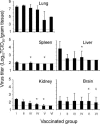Protection of mice against lethal infection with highly pathogenic H7N7 influenza A virus by using a recombinant low-pathogenicity vaccine strain
- PMID: 16160167
- PMCID: PMC1211531
- DOI: 10.1128/JVI.79.19.12401-12407.2005
Protection of mice against lethal infection with highly pathogenic H7N7 influenza A virus by using a recombinant low-pathogenicity vaccine strain
Abstract
In 2003, an outbreak of highly pathogenic avian influenza occurred in The Netherlands. The avian H7N7 virus causing the outbreak was also detected in 88 humans suffering from conjunctivitis or mild respiratory symptoms and one person who died of pneumonia and acute respiratory distress syndrome. Here we describe a mouse model for lethal infection with A/Netherlands/219/03 isolated from the fatal case. Because of the zoonotic and pathogenic potential of the H7N7 virus, a candidate vaccine carrying the avian hemagglutinin and neuraminidase proteins produced in the context of the high-throughput vaccine strain A/PR/8/34 was generated by reverse genetics and tested in the mouse model. The hemagglutinin gene of the recombinant vaccine strain was derived from a low-pathogenicity virus obtained prior to the outbreak from a wild mallard. The efficacy of a classical nonadjuvanted subunit vaccine and an immune stimulatory complex-adjuvanted vaccine was compared. Mice receiving the nonadjuvanted vaccine revealed low antibody titers, lack of clinical protection, high virus titers in the lungs, and presence of virus in the spleen, liver, kidneys, and brain. In contrast, mice receiving two doses of the immune stimulatory complex-adjuvanted vaccine revealed high antibody titers, clinical protection, approximately 1,000-fold reduction of virus titers in the lungs, and rare detection of the virus in other organs. This is the first report of an H7 vaccine candidate tested in a mammalian model. The data presented suggest that vaccine candidates based on low-pathogenicity avian influenza A viruses, which can be prepared ahead of pandemic threats, can be efficacious if an effective adjuvant is used.
Figures





Similar articles
-
Development of Eurasian H7N7/PR8 high growth reassortant virus for clinical evaluation as an inactivated pandemic influenza vaccine.Vaccine. 2008 Mar 25;26(14):1742-50. doi: 10.1016/j.vaccine.2008.01.036. Epub 2008 Feb 13. Vaccine. 2008. PMID: 18336962
-
Protective immunity against influenza H5N1 virus challenge in mice by intranasal co-administration of baculovirus surface-displayed HA and recombinant CTB as an adjuvant.Virology. 2008 Oct 25;380(2):412-20. doi: 10.1016/j.virol.2008.08.002. Epub 2008 Sep 10. Virology. 2008. PMID: 18786689
-
Pathogenesis of and immunity to avian influenza A H5 viruses.Biomed Pharmacother. 2000 May;54(4):178-87. doi: 10.1016/S0753-3322(00)89024-1. Biomed Pharmacother. 2000. PMID: 10872716
-
Identification of effective constituents of influenza vaccine by immunization with plasmid DNAs encoding viral proteins.Jpn J Infect Dis. 2000 Dec;53(6):219-28. Jpn J Infect Dis. 2000. PMID: 11227019 Review.
-
Trends in development of the influenza vaccine with broader cross-protection.Acta Virol. 2010;54(1):7-19. Acta Virol. 2010. PMID: 20201609 Review.
Cited by
-
Transient expression of hemagglutinin antigen from low pathogenic avian influenza A (H7N7) in Nicotiana benthamiana.PLoS One. 2012;7(3):e33010. doi: 10.1371/journal.pone.0033010. Epub 2012 Mar 19. PLoS One. 2012. PMID: 22442675 Free PMC article.
-
Designing vaccines for pandemic influenza.Curr Top Microbiol Immunol. 2009;333:165-76. doi: 10.1007/978-3-540-92165-3_8. Curr Top Microbiol Immunol. 2009. PMID: 19768405 Free PMC article. Review.
-
Avian influenza H7N9/13 and H7N7/13: a comparative virulence study in chickens, pigeons, and ferrets.J Virol. 2014 Aug;88(16):9153-65. doi: 10.1128/JVI.01241-14. Epub 2014 Jun 4. J Virol. 2014. PMID: 24899194 Free PMC article.
-
Pathogenesis and Transmission Assessments of Two H7N8 Influenza A Viruses Recently Isolated from Turkey Farms in Indiana Using Mouse and Ferret Models.J Virol. 2016 Nov 14;90(23):10936-10944. doi: 10.1128/JVI.01646-16. Print 2016 Dec 1. J Virol. 2016. PMID: 27681133 Free PMC article.
-
A live attenuated H7N7 candidate vaccine virus induces neutralizing antibody that confers protection from challenge in mice, ferrets, and monkeys.J Virol. 2010 Nov;84(22):11950-60. doi: 10.1128/JVI.01305-10. Epub 2010 Sep 1. J Virol. 2010. PMID: 20810733 Free PMC article.
References
-
- Crouch, C. F., J. Daly, D. Hannant, J. Wilkins, and M. J. Francis. 2004. Immune responses and protective efficacy in ponies immunised with an equine influenza ISCOM vaccine containing an ‘American lineage’ H3N8 virus. Vaccine 23:418-425. - PubMed
-
- de Wit, E., M. I. Spronken, T. M. Bestebroer, G. F. Rimmelzwaan, A. D. Osterhaus, and R. A. Fouchier. 2004. Efficient generation and growth of influenza virus A/PR/8/34 from eight cDNA fragments. Virus Res. 103:155-161. - PubMed
-
- Fouchier, R. A., B. Olsen, T. M. Bestebroer, S. Herfst, L. van der Kemp, G. F. Rimmelzwaan, and A. D. Osterhaus. 2003. Influenza A virus surveillance in wild birds in Northern Europe in 1999 and 2000. Avian Dis. 47:857-860. - PubMed
Publication types
MeSH terms
Substances
LinkOut - more resources
Full Text Sources
Other Literature Sources
Medical
Research Materials

